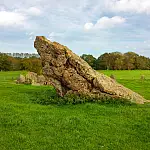Stonehenge - A Neolithic Henge and Stone CircleStonehenge is one of the most famous megalithic monuments in England. Its construction and purpose have been a constant source of mystery.
Stonehenge comprises thirty upright stones, which weigh more than 26 tonnes each, as much as four adult elephants, positioned in a circle, with thirty capstones of 6 tonnes each, placed horizontally atop the posts in a continuous circle. There is a single erect stone called the "Heel Stone" that forms an "entrance path" to the circle, which is set at a distance from the other stones. The stones were excavated from a quarry at Carn Menyn, high in the Preseli Hills of Pembrokeshire. The stone was then carved and transported over 240 miles to Salisbury Plain; the method of transportation is unknown.
At a dig site in the Preseli Hills, a team led by Professor Mike Parker Pearson found evidence that the stones used to create Stonehenge were first used in a different monument in Wales.

The heel stone is said to have been thrown by the Devil at a monk who was spying on him between the stones. The stone pinned the unfortunate clergyman to the ground by his heel.
How Was Stonehenge Built?
Aliens, giants, or even team-building exercises are some of the theories that attempt to explain Stonehenge's origins.
The construction, and purpose, of Stonehenge have been a mystery and remain one. Whoever built it left no written record and few clues behind for us to piece together this ancient puzzle.
Like the ancient Pyramids of Egypt, there are many theories about how Stonehenge was built and how the stones were transported. Some are perfectly rational explanations, while others are way out there.
What we do know is that Stonehenge was built in phases. The first phase is a great circular ditch about six feet deep with a bank of dirt within it about 360 feet in diameter. A large entrance was located to the northeast and a smaller one to the south. The circular ditch and bank together are called a henge. Within the henge were 56 pits, each slightly more than three feet in diameter, called Aubrey holes and date to around 3100 BC.
The second phase of work at Stonehenge occurred approximately 100-200 years later and involved the setting up of upright wooden posts. During this second phase, it was used for burial. At least 25 of the Aubrey holes were emptied and used for cremation burials. Another 30 cremation burial pits were dug into the ditch of the henge and in the eastern portion of the henge enclosure.
The third phase of construction at Stonehenge happened approximately 400-500 years later, the remains of which we see today.
All three phases required a great deal of planning and labour.
How did they shift 24 tonnes of rock and stand it upright? The most popular theory is that tree trunks were cut and carved to make sledges and rafts. These were then dragged by workers and oxen. When the stones were near their final resting place, they were tipped into holes using levers and counter levers.
Some of the more out-there theories include claims that ancient aliens came to Earth and provided the necessary knowledge and tools, or that the Nephilim, a race of giants who were almost totally wiped out by Noah's flood, used their greater height and strength to help build Stonehenge.
Purpose of Stonehenge
The overall purpose of Stonehenge is still unknown, although there are many theories. The Jacobean architect Inigo Jones thought it was a Roman ruin, James Douglas was the first to recognise the alignments with the midsummer sunrise in the late 18th century. However, it was in the 12th century that Gerald of Wales (Giraldus Cambrensis), a historian of the 12th century, wrote a book titled The History and Topography of Ireland in which he surmised that Stonehenge was designed and engineered by Merlin. He said that Aurelius Ambrosius, King of the Britons, had Merlin bring the stones to Britain. However, the archaeological evidence at Stonehenge does not support an Arthurian date of construction. The evidence points to a date between 3,000 BC and 1,000 BC.
Some believe Stonehenge has supernatural origins and some neopagans think was a place of worship for the Druidic "old religion." Archaeologists note that the monument is older than the Druid religion which dates from the Iron Age. The idea that Stonehenge was built by the Druids was first proposed in the mid-20th century by Aubury and Stukeley, who had little knowledge of pre-Roman Britain. The idea stuck and has now become a myth.
The construction and alignment of Stonehenge suggest a relationship with astronomy. In a recent book entitled "Stonehenge Decoded", Gerald Hawkins, a Professor of Astronomy, concluded that Stonehenge is a sophisticated astronomical observatory designed to predict eclipses. The positioning of the stones allows an observer to accurately predict every important lunar event for hundreds of years. The computer needs resetting about once every 300 years by advancing the stones by one space.
"Stonehenge was like a giant computer, a huge observatory capable of extremely complex calculations based on the sun, moon and stars. The men that built it had proved that very feat that they were not primitive."
Gerald Hawkins
When accurate survey data on the position of the stones around the Stonehenge site was compared with astronomical data, it showed a few curious insights. They found that the sunrise point on a midsummer's day corresponds with certain stones, and was able to predict eclipses and other major recurring astronomical events.
If the academics were right and Stonehenge (and other standing stones) were designed as astronomical observatories, there was likely an intellectual elite within the primitive stone-age farmers. An age when planetary alignments can be calculated, whilst, at the same time, there is no form of the written word.
Religion at Stonehenge
One of the prevailing theories is that Stonehenge served as a religious or ritualistic site. The alignment of the stones with celestial events, such as the summer solstice, has led to suggestions that it was used for religious ceremonies, observations of astronomical phenomena, or rituals related to the cycles of the sun and moon. Stonehenge is a place of annual pilgrimage for neo-druids and those following pagan or neo-pagan beliefs. The midsummer solstice began attracting modern visitors in the 1870s, with the first record of recreated Druidic practices dating back to 1905 when the Ancient Order of Druids enacted a ceremony.
In more recent years, the setting of the monument has been affected by the proximity of the A303 road between Amesbury and Winterbourne Stoke, and the A344. In early 2003, the Department for Transport announced that the A303 would be upgraded, including the construction of the Stonehenge road tunnel.
Other Theories for Stonehenge
Stonehenge, a prehistoric monument located in Wiltshire, England, has long been a subject of fascination and speculation regarding its purpose and significance. While there is no definitive answer, several theories have been proposed by scholars and researchers. Some of the prominent theories include:
- Ceremonial Burial Site - Some researchers propose that Stonehenge was a burial site. Excavations have revealed human remains in the vicinity, suggesting that the monument may have been used for burial ceremonies or rituals associated with the deceased.
- Astronomical Observatory - Stonehenge's alignment with celestial events has led to the idea that it may have functioned as an astronomical observatory. The positions of the stones, markers, and the avenue leading to Stonehenge have been linked to the tracking of the sun, moon, and stars.
- Healing or Religious Center - Alternative theories suggest that Stonehenge was a centre for healing or religious practices. The bluestones, believed to have originated from Wales, may have been associated with healing properties, and the site could have been a destination for pilgrims seeking spiritual or healing experiences.
- Cultural or Social Gathering Place - Stonehenge may have served as a gathering place for cultural or social events. The structure's design and layout could have accommodated large groups of people for communal activities, celebrations, or festivals.
- Symbolic Representation of Cosmology - Stonehenge's intricate design and alignment with celestial bodies may symbolize a cosmological belief system. Some researchers suggest that the monument reflects the worldview or religious beliefs of the people who built it.
- Ancient Calendar System - Stonehenge's alignment with astronomical events has led to the proposal that it functioned as a calendar system, helping ancient communities track the changing seasons for agricultural and ceremonial purposes.
- Status Symbol or Display of Power - Stonehenge could have served as a symbol of status or power for the communities involved in its construction. The effort and resources required to build such a monument may have contributed to the social and political significance of the site.
The mystery surrounding Stonehenge persists, and these theories are not mutually exclusive. It is possible that the site had multiple functions over time or served different purposes for different communities. Ongoing research and archaeological discoveries may continue to shed light on the true nature and purpose of Stonehenge.












